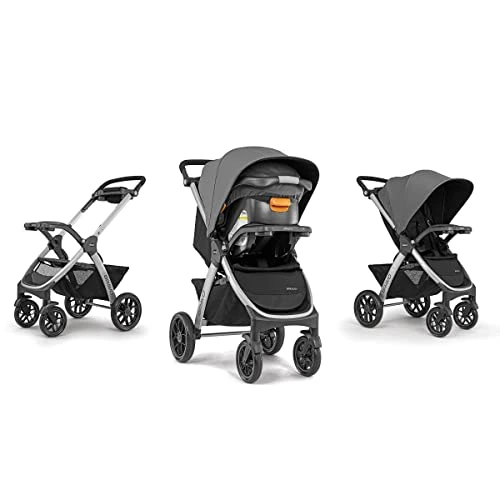
A stroller is not just something you push. It becomes part of your daily rhythm. From early morning walks to quick store runs, it moves with you. It holds your child, your bag, your coffee, and sometimes even your patience.
That’s why choosing one isn’t about picking the flashiest option or the trend you saw online. It’s about finding what works with the way you live.
This article will walk you through how to match a stroller to your routine. Whether you’re in a busy city, a quiet suburb, or somewhere in between, the right fit depends on your day-to-day needs. Not guesses. Not guesses. Just what works.
The Best Stroller Is the One That Fits Your Routine
The right stroller depends on how you live, not just how much you want to spend or what brand looks popular.
A stroller that fits your routine makes daily life easier. One that doesn’t will sit in the corner, unused, while you wrestle with something too bulky, too flimsy, or too hard to fold. That’s money down the drain and stress you didn’t sign up for.
Picture this. A city parent buys a big stroller with thick wheels and lots of storage. It sounds great until they’re stuck at a crowded train station, trying to carry it up stairs with one hand and balance a bag in the other. On the flip side, a runner picks a small travel stroller and ends up with shaky wheels and a baby who wakes up at every bump.
It’s not about more features. It’s about the right features. The kind that fit where you live, how you move, and what your days actually look like.

Types of Strollers and What They’re Made For
Not all strollers are built the same. Each type serves a different need, and knowing which one suits your routine helps avoid second-guessing later.
Full-Size Strollers
These are solid, everyday strollers made for longer walks, errands, and full days out. They often come with roomy baskets, solid wheels, and adjustable seats.
Best for: city living, frequent outings, long walks
A good fit for parents who do a lot on foot. Picture a morning walk to daycare, a stop at the bakery, and a loop through the park — all with your child in tow.
Lightweight Strollers
These are simple, compact, and easy to fold. They don’t have all the extras, but they’re quick to grab and go.
Best for: travel, errands, or tossing in and out of the trunk
Perfect for grandparents or anyone who travels often. It folds fast, fits in small spaces, and doesn’t weigh you down.
Jogging Strollers
These strollers are built for speed and stability. They have larger wheels and better suspension to handle rough paths or uneven sidewalks.
Best for: running, hiking, uneven sidewalks
If you plan to jog with your child, make sure the stroller has a safety strap, hand brake, and a strong frame. It keeps both of you steady while you move.
Travel Systems
This setup includes a stroller and a car seat that click together. You can move your baby from car to stroller without taking them out of the seat.
Best for: newborn stage, car-to-stroller transfers
Think of those naps that start in the car. With a travel system, you don’t need to wake your baby when it’s time to switch.
Double Strollers
These strollers carry two children at once. They come in two styles: side-by-side and front-to-back (called tandem).
Best for: twins, siblings close in age
Side-by-side strollers give both kids equal space but can be wider. Tandem strollers are slimmer but one seat may get less legroom. The better choice depends on where and how you plan to use it.
Match Your Stroller to Your Daily Life
Where you live and how you move each day should shape the kind of stroller you choose. Different settings call for different features. Here’s how to match your stroller to your routine.
City Living
In a busy city, space is tight and sidewalks are crowded. You need a stroller that can keep up.
What to look for:
- Durable wheels that handle curbs and uneven pavement
- A compact fold that fits in elevators, cafes, and small closets
- Easy turning to move through crowds and tight corners
What to avoid: Bulky strollers can get stuck in doorways, make public transport harder, and wear you out fast.
Suburban Living
In the suburbs, you’re likely using your car often and spending more time on wide sidewalks or paved paths.
What to look for:
- A stroller with enough storage for snacks, bags, and supplies
- Smooth ride and padded seats for longer outings
- Car seat compatibility for quick transfers
Tip: Go for extras like a cup holder and a large basket. They make daily errands smoother.
Rural or Uneven Terrain
If you’re often walking on gravel, grass, or trails, a basic stroller won’t cut it.
What to look for:
- Strong suspension to absorb bumps
- Air-filled tires for grip and balance
- A sturdy frame that won’t rattle or tip
Real-life example: Think of a parent walking down a dirt path to get to the mailbox or across a grassy park — those wheels need to hold up.
Active Lifestyle
If you’re running, hiking, or just want a stroller that stays steady on the move, your needs are more specific.
What to look for:
- A safety strap that wraps around your wrist
- A hand brake for downhill control
- Shock absorption for a smoother ride
Tip: Make sure it’s tested and marked safe for jogging. Not all strollers that look sporty are made for speed.
What to Consider Before You Buy
Buying a stroller is not just about colors, price tags, or brand names. It’s about how well that stroller fits into your real, daily life — not the one in ads, but the one with grocery bags, skipped naps, and quick diaper changes in public restrooms.
A stroller becomes part of your routine. Before spending money, take time to think through the points that matter most.
1. How Often Will You Use It?
This one detail shapes almost every other choice.
- If you’re walking daily, you’ll want a sturdy frame, smooth wheels, and a comfortable seat your child can nap in.
- If your stroller will live in the trunk and come out once a week for errands, lighter weight and foldability take priority.
- Occasional use? Focus on convenience. Frequent use? Focus on comfort, build, and long-term value.
The wrong guess here leads to quick regret — and often, a second stroller.
2. Where Will You Store It?
Strollers look smaller in showrooms than they do in your hallway.
- Measure your closet or entryway before buying.
- Folding size is not just about saving space — it’s about everyday function.
- Some strollers fold with one hand and stand upright on their own, which helps when you’re carrying your child or groceries.
If you live in an apartment or have a small car, storage will quickly become a deciding factor.
3. How Will You Transport It?
Think about all the places this stroller will need to go.
- Do you take the subway? You’ll want a compact fold and a light frame.
- Do you often lift things into the trunk? Try folding and lifting the stroller before you buy it.
- Have stairs at home? A heavy stroller might feel impossible after a long day.
It’s easy to forget about stairs, curbs, and car trunks when shopping — until they become part of your daily struggle.
4. Will It Grow with Your Child?
Not all strollers are made to last through toddler years.
- Some start at 6 months and don’t recline flat, which means you’ll need a newborn insert or a separate option for early months.
- Others come with adjustable seats, footrests, and handles, so they work from birth through preschool.
- Check the weight and height limits to avoid outgrowing the stroller too soon.
A long-lasting stroller might cost more upfront, but it saves you from buying twice.
5. Do You Need It to Work with a Car Seat?
If you’ll be driving often with a newborn, this one is key.
- A travel system lets you snap the car seat directly onto the stroller.
- That means no waking a sleeping baby and no extra steps at every stop.
- Make sure the car seat and stroller are either made to work together or are compatible through adapters.
If your baby will spend a lot of time in the car, this feature can be the difference between peace and frustration.
6. How Much Are You Willing to Carry?
It’s easy to get sold on features — big wheels, snack trays, cup holders, full sun canopies. But all those add weight.
- Think of the days when you’ll carry your baby in one arm and need to fold and lift the stroller with the other.
- If it takes more than a few seconds to fold, or if it feels like lifting luggage, you might end up avoiding it.
- Find the right balance between features and practicality.
Sometimes the simpler model is the one that gets used the most.
Final Thoughts
Choosing a stroller isn’t about picking the flashiest model or following trends. It’s about knowing your day-to-day needs and finding something that works with them, not against them. The right stroller should feel like a helpful extra set of hands not another thing to wrestle with. The best choice is the one that makes your routine smoother, your outings simpler, and your baby more comfortable. Think about how you move through the world, then pick a stroller that fits into that world not the other way around.
